The crowned eagle, the third largest and the most powerful African eagle, has found a way to survive in close proximity to some urban areas in parts of eastern South Africa.
Key to crowned eagles – who are forest and woodland specialists – being able to live and even breed near urban areas are sufficient patches of indigenous forest in combination with pockets of dense bush and exotic plantations, such as eucalyptus and pine plantations. Not only do such environments provide sufficient habitat for prey animals but they also provide suitably large trees for nesting.
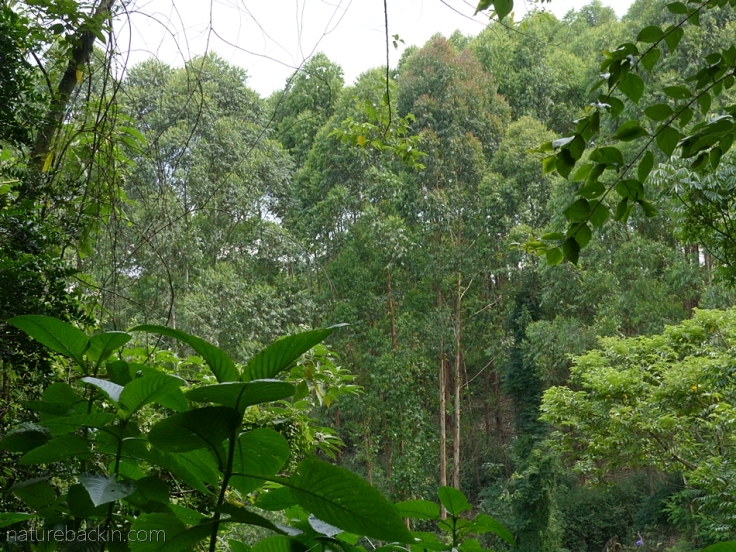
A view from our garden of a section of the neighbouring eucalyptus plantation on the opposite slope. These eucalyptus trees are fast growing and entire compartments are harvested at the same time every few years, so only stray trees that have self-seeded on the margins have a chance to mature into large specimens suitable for eagle nesting sites. Unfortunately, most of the old eucalyptus trees in our neighbourhood have been removed
It is somewhat surprising that such a large eagle has been able to adjust to surviving around built-up environments. Crowned eagles (Stephanoaetus coronatus) are powerful predators and they are able to capture prey that is several times their own weight. The average weight of a crowned eagle is in the region of 3.6 kg (8 lbs), with the female being larger than the male. The broad wings that are short relative to their size and the long broad tail, enable crowned eagles to manoeuvre accurately in between the trees and understorey vegetation in their forest or woodland habitats. Despite the relative shortness of their wings, their wingspan is nevertheless an impressive 1.5–2m on average (about 5–6.5 ft).
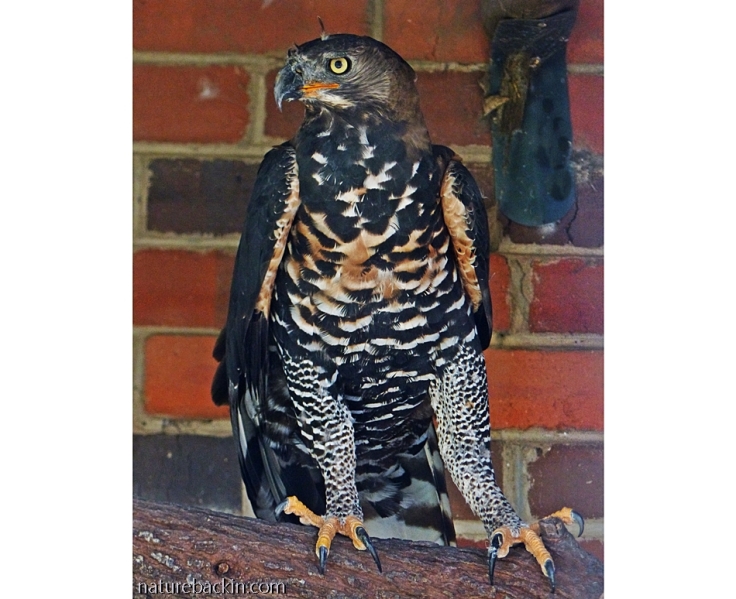
In the above photo, a crowned eagle, with its crown of feathers folded flat, shows its camouflaging colouration and its powerful legs and feet equipped with strong talons (the very large hind claws are concealed) for seizing and killing prey. This eagle (the same one as in the header photo) was rescued after being hit by a car. Although its injuries – including a broken wing – healed, it was not fit to fly well enough to be released and it now lives in captivity at the African Bird of Prey Sanctuary near Pietermaritzburg
In our neighbourhood we are most aware of the crowned eagles when they fly overhead calling loudly and repetitively during their aerial territorial or courtship displays. Sometimes we become aware of their presence due to the alarm calls of vervet monkeys and/or the anxious rallying and calling of hadeda ibisis – both species preyed upon by crowned eagles.
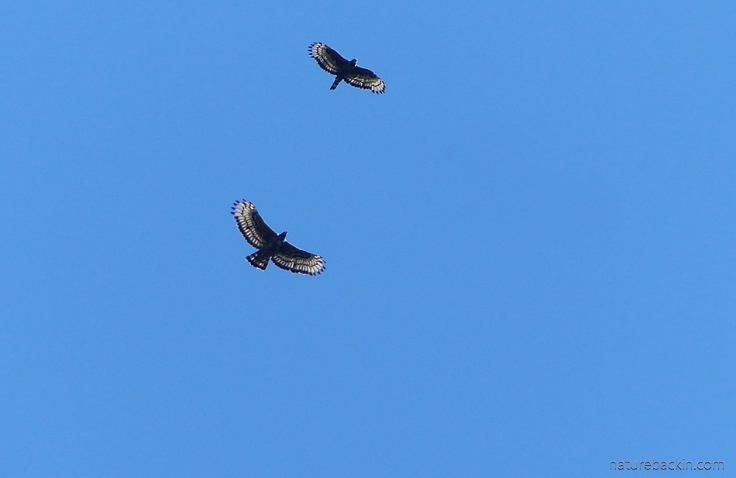
A pair of crowned eagles in aerial display above our garden
I do not know where this pair of crowned eagles is nesting, but I hope their nesting tree is safe from being felled. As I mentioned in last week’s post on long-crested eagles, I have posted about the black sparrowhawks that used to nest behind our house who were displaced by the felling of old eucalyptus trees despite their specific nesting tree being saved.
In a study of breeding pairs of crowned eagles, which included the greater Durban and Pietermaritzburg areas (MacPherson 2015), it was found that mature eucalyptus trees were the favoured nesting trees of crowned eagles in this region. However, an ongoing initiative to remove these invasive and water-thirsty exotic trees has seen the removal or ringbarking even of actively used nesting trees of crowned eagles and black sparrowhawks (p.33). Where such trees provide raptor nesting sites in the absence of any alternatives, it would seem that such removal policies need rethinking. For example, as suggested by MacPherson, stands of mature eucalyptus trees could be under-planted with suitable indigenous tree species to replace the eucalyptus trees and restore forest patches over time (p.34).

Unfortunately, all but one of these older eucalyptus trees that used to grow on slopes between the residential area and the plantation have been felled. On the opposite slope (from where this photo was taken) is the start of the eucalyptus plantation where the trees are clear cut when at harvesting age
Adult crowned eagles form monogamous breeding pairs and they are known to return to the same nest year after year. Depending on factors such as habitat, food resources and climate conditions, in some regions they breed every two years and in others they breed annually, which is the case in the Durban area (MacPherson, 2015).
Crowned eagles lay two eggs but only raise one chick (the older chick is programmed to kill the younger chick). The developmental process is long and a youngster is dependent on being provided with food by the parents until it is 7 to 12 months old. It then has to depart and make its own way in the world.
Juvenile crowned eagles are very different in appearance from adults – they are much paler with the head and underparts being creamy white. The wings and upper-parts are a brownish-grey with a faint barring on the feathers that are outlined in creamy white creating a scalloped look. The tail is barred as in the adult.
The first two years of life for a juvenile crowned eagle are particularly difficult and many do not survive. Crowned eagle sub-adults reach breeding-age maturity when they are 4–6 years old.
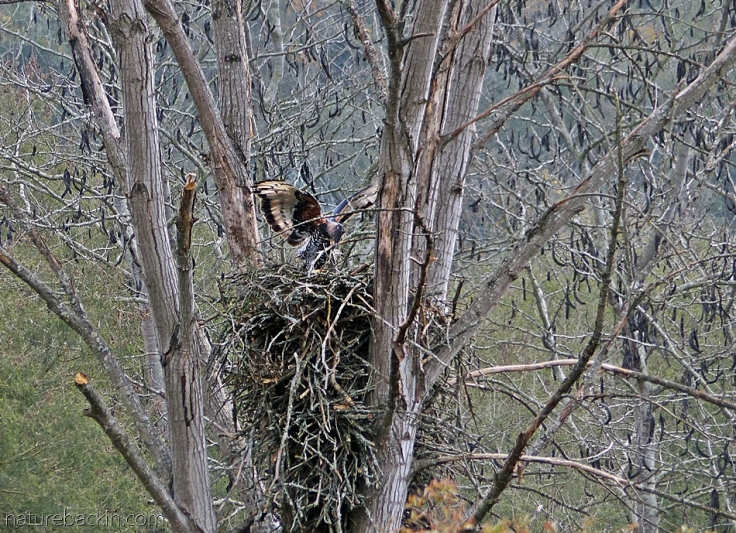
About two years ago I photographed a pair of nesting crowned eagles in the rural Mpushini Valley. As can be seen by the density of sticks this nest has been in use for some years. One of the parents is at the nest rearranging nesting material at the commencement of the breeding season
The study of crowned eagles in the Durban, Pietermaritzburg and adjacent regions in KwaZulu-Natal included placing cameras at nests in order to ascertain what prey animals were brought to the nest (MacPherson 2015). In most prior studies bones found at the base of nesting trees were a primary means of determining prey animals. The advantage of using cameras at nests is that they were able to show soft-boned prey animals brought to the nest, such as fledgling birds, which would be consumed completely leaving no remains to be found beneath the nest.
From the prey items identified in the study (a total of 836 items), rock hyrax (42.2%) were in the majority with hadeda ibis second (19.4%), and of these 89% were young birds not yet able to fly. Next in order, were blue duiker and vervet monkey. Other prey items included grey duiker, one bushbuck, and small mammals such as mongooses. Very few domestic animals were brought to the nest. There were several chickens (3.3%), 7 domestic cats (pets or feral) comprising 0.8% of the total, and no dogs.
After having witnessed in our neighbourhood what appeared to be an ongoing war between Egyptian geese harassing the black sparrowhawks when they were actively nesting – Egyptian geese are known to takeover abandoned or disused raptor nests – I was fascinated to read in the MacPherson study that the camera at one nesting site showed that a breeding pair of Egyptian geese moved into a crowned eagle nest already accommodating a young crowned eagle fledgling and cohabited in the same nest (MacPherson 2015: 104).
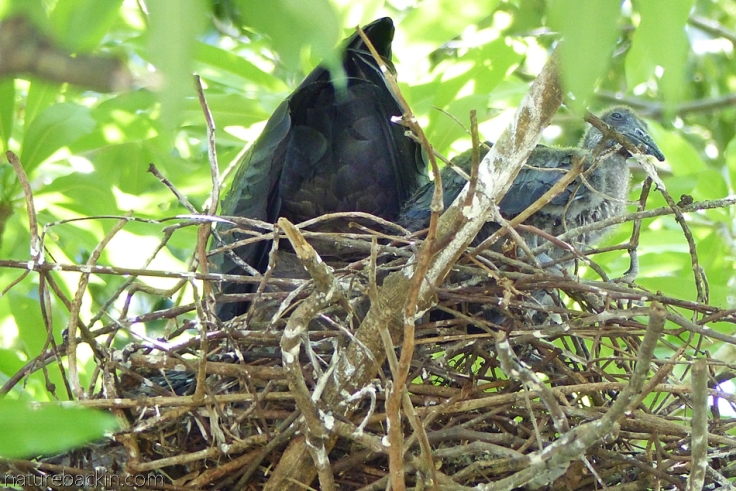
A hadeda ibis fledgling, favoured prey of crowned eagles, perched in its rather scraggy-looking platform nest alongside its parent. The nest was in a tree in our neighbour’s garden above our fence line and I took this photo from our garden
It is known that small pet dogs (and pet cats) have been taken by crowned eagles from their owners gardens, but in most cases such pets are taken by juvenile eagles who are inexperienced hunters, and mostly during the months of winter when times are hard. The instances of pets taken by crowned eagles are of course most distressing, but proportionally the numbers are small, not that that is of any comfort to anyone losing a precious pet.
We think one of our beloved cats was killed and then for some reason abandoned by a crowned eagle in our garden. Perhaps it was disturbed by our two dogs. Although we cannot be certain, we think the cat was most likely killed by an eagle because of the nature of the puncture injuries at the back of the cat’s neck and spine. (Distressingly, those same dogs did kill a visiting cat that strayed into our garden, but that cat died from crush injuries and from being shaken with no visible punctures or openings in the skin.)
Since the killing of our cat fifteen years ago, and for other reasons too, our cats now have outdoor access from the house to an enclosed garden. Not only does it keep them safe from hazards that include predators, cat fights and vehicles, it importantly also curtails the cats’ opportunities for recreational hunting. Although I was completely devastated by the killing of our cat, I believe that it is our responsibility to devise ways to live as harmoniously as possible with wildlife, including when wild animals and birds find ways of surviving in suburban areas.
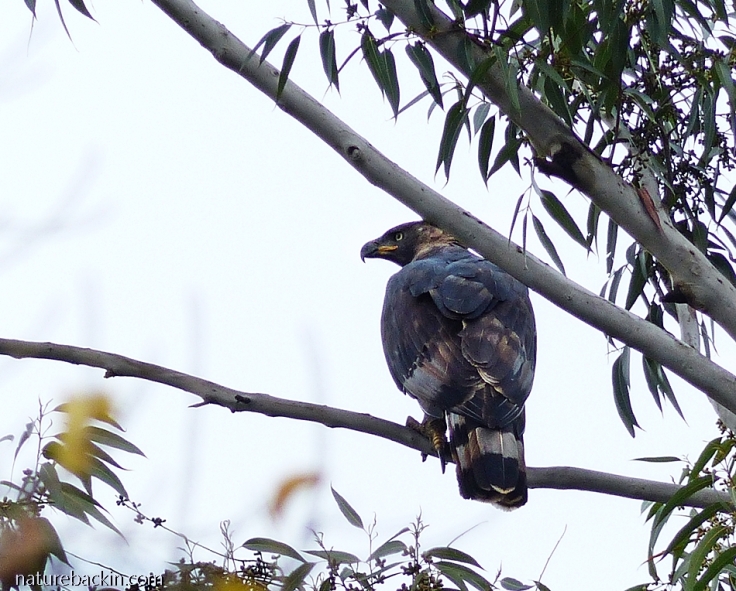
I was alerted by hadedas raising the alarm to the presence of this crowned eagle, perched in the eucalyptus tree (abandoned by the black sparrowhawks) outside our garden from where it surveyed the plantation. Like most crowned eagles, this bird was not only alert but extremely wary so I had to stay as concealed as possible and at a considerable distance as I took this photo from near our house
Crowned eagles most commonly use an ambush-style of hunting. They patiently wait perched up in a tree in the forest or woodland usually above a known nature path and drop down from their perch onto a prey animal passing underneath. The prey is killed on the ground. An animal that is too large to lift whole will be dismembered and parts delivered to the nest or taken away in sections to be stashed or eaten.
Crowned eagles do also hunt on the wing and hunting may be done by a pair working in cooperation with one flushing the prey, for example monkeys, with the other one following up to catch an animal or bird as it flees.
A few months ago I heard a crowned eagle calling repeatedly from nearby. I went outside with my camera to discover a vervet monkey alarm-calling from the edge of the plantation while watching the crowned eagle that was perched in a nearby tall tree, concealed from my view by another large tree in between.
I recorded the calling of the unseen crowned eagle by taking a video showing the foliage of the intervening tree, and then I crept down to the back fence and filmed the very agitated vervet monkey sounding the alarm. When I tried to peek round the vegetation to get a view of the eagle it flew away – I think I frightened it off. After the eagle’s departure one monkey ascended into a tree to assume a lookout role while some youngsters broke cover to play and forage in the relative safety of a dense stand of (alien and invasive) lantana and Mauritius thorn. Although a bit snippety as I had no idea what was going to happen next as it unfolded, the video I captured is below.
In the IUCN Red List the crowned eagle is classed as Near Threatened with the population decreasing. Crowned eagles occur in forested and woodland areas over much of central Africa and also down the southern eastern side of the continent into South Africa. Threats to crowned eagles include deforestation where forests are depleted or destroyed to provide or make way for timber, agriculture, palm oil trees, charcoal and mining, for example, and in some regions crowned eagles are deliberately targeted to be killed where they are seen as competing for bush meat.
In the study on crowned eagles undertaken in KwaZulu-Natal, in addition to habitat destruction that includes deforestation and the felling of nesting trees, threats to crowned eagles that resulted in the deaths of crowned eagles in the study area included collisions with vehicles and barriers such as walls, wire fences and window panes, as well as deaths caused by gunshot wounds and electrocution. These factors caused 80% of the deaths of crowned eagles recorded in this study. Other causes of death included harassment by people or pets and one case of poisoning (MacPherson 2015, p.81). Work is ongoing with the providers of electricity to insulate and design more bird-friendly installations, and ongoing citizen-science initiatives are intended to raise public awareness and participation in the protection and management of urban wildlife species.
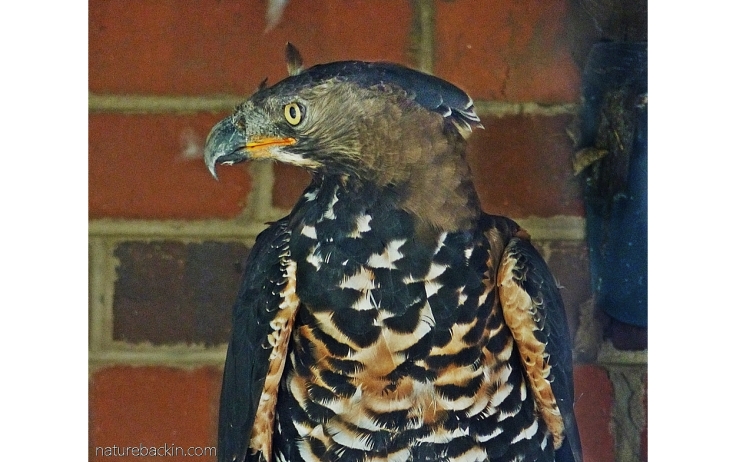
I do not have a photograph of a crowned eagle raising its double crest that forms a crown of feathers when erect. However, in this photo the white tips of the crest feathers on the top of the head are visible even when the crest is lying flat
We are fortunate to live in a region with a mosaic of different vegetation types and land usages, an environment that enables a diversity of vegetation and animal and birdlife to survive. It is to be hoped that despite the ongoing development of “urban sprawl” this variety can be maintained. And just as some wildlife species are finding ways of adapting to people, so too it is to be hoped that more and more people are prepared to find ways to adapt to and accommodate wildlife in their midst.
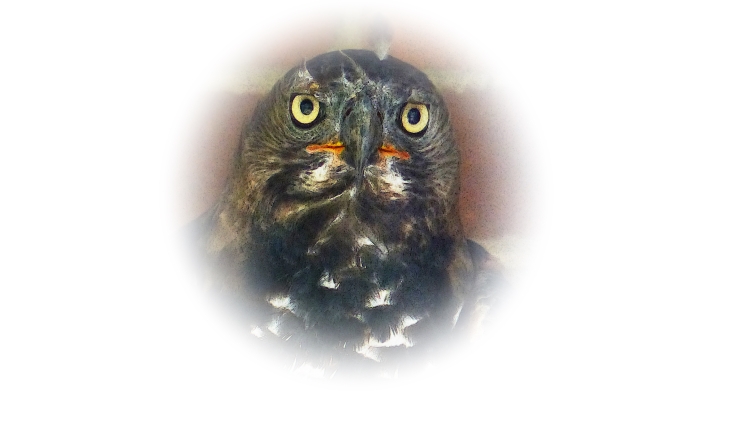 References:
References:
BirdLife International. 2018. Crowned Eagle Stephanoaetus coronatus . The IUCN Red List of Threatened Species 2018. https://www.iucnredlist.org/species/22696201/129914678; Chittenden, Hugh, Davies, Greg & Weiersbye, Ingrid. 2016. Roberts Bird Guide: Illustrating nearly 1,000 Species in Southern Africa (2nd edition). Cape Town: Jacana; McPherson, Shane C. 2015. Urban Ecology of the Crowned Eagle Stephanoaetus coronatus in KwaZulu-Natal, South Africa. PhD dissertation. Pietermaritzburg: University of KwaZulu-Natal. https://pdfs.semanticscholar.org/d3de/c417ed8e547ecca352cf32fa0cb22e30fba0.pdf; McPherson, Shane. [n.d.] Crowned Eagles in the Big City. The Leopard’s Echo. https://le.kloofconservancy.org.za/crowned-eagles-in-the-big-city/; Wikipedia. 2020. Crowned Eagle. https://en.wikipedia.org/wiki/Crowned_eagle
Posted by Carol

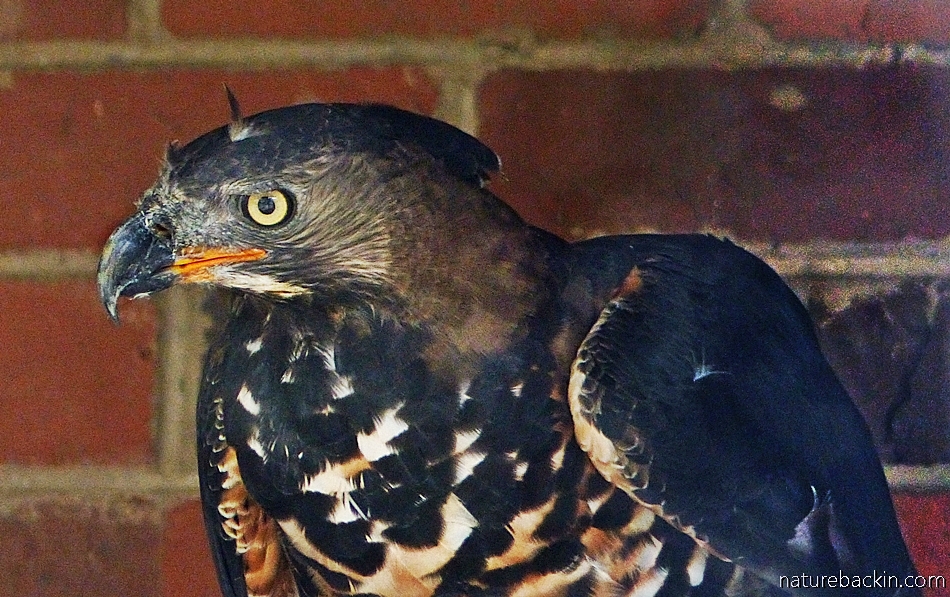







August 22, 2020 at 5:45 am
Thank you for the well researched information I live near the Kloof gorge A number of domestic cats have been taken by the Eagle I have a cat and small dog (also a labrador which I assume would not be attractive to the Eagle) What I want to know is whether these Eagles rely on thermals I only see and hear them first at around 11am I assume that the thermals arent formed earlier say before 9am so bring my small animals under house lockdown from 9am to 4pm Am I correct in this assumption? I have mostly spreading trees over my garden like flat crowns so it is probably less visible to a hunting eagle so I keep them inside for most of the day I would be pleased if you could advise me on the lockdown times
LikeLiked by 1 person
August 22, 2020 at 4:33 pm
Hi Sue. Thanks for your comment. I am not an expert, but from what I have read crowned eagles commonly hunt from perches (such as in trees in the forest patches), and ambush hunting is a commonly used strategy.
When they fly high and are vocal they are usually engaging in territorial or breeding display rather than hunting.
However, like any predator they will be opportunistic. Even if there are times of the day when they are more likely to hunt (unfortunately I don’t know such details) specific conditions may intervene. Juvenile birds are likely to have different behaviour and hunting patterns to mature pairs.
To keep our cats safe we have constructed an enclosed garden on two sides of the house for them. See details here https://naturebackin.com/2017/02/16/cats-and-the-wildlife-garden/
Perhaps you may want to consider something along these lines? It will help keep your small dog safe too when you are not around. I have read about stretching a few lengths of thick string above head height to crisscross a few times over such an enclosure as a further deterrent to raptors, but I don’t know if it is worth doing or not. We have put up a few such strands in our cats’ garden.
Sorry not to be able to give you more specific information. I really do understand your concern for your small animals.
LikeLike
July 9, 2020 at 12:37 am
My parents live in the Valley of Thousand Hills. When I was visiting, from NZ, last year I heard and saw eagles from their home but I couldn’t identify the specific one. Are you able to tell me which eagles nest in this particular area? I’m delighted to discover your blog and will spend a lot of time reading your posts. As a teenager in KZN I didn’t appreciate then the rich diversity of wildlife and fauna.
LikeLiked by 1 person
July 9, 2020 at 8:25 pm
Hallo Roz – how good to connect and I look forward to browsing your blog. Yes KZN is rich in flora and fauna – so rich its hard to narrow down which eagle you may have seen nesting! Are you sure it was an eagle and not another large raptor such as a black sparrowhawk? Were they nesting in a tree or on a rocky cliff? I will see if I can find a list of KZN raptors that you can link to and get back to you.
LikeLike
July 10, 2020 at 8:11 pm
I didn’t see the nests – my parents live in Montoseel at the top of the gorge with a view right over the valley. I heard the eagle ‘screeching’ and saw it flying higher than any of the usual birds fly but couldn’t catch the details of it.
LikeLiked by 1 person
July 11, 2020 at 7:26 pm
Hi Roz, there are a few ‘true’ eagles that might breed in that region of KZN and these include the Verreaux’s Eagle (Black Eagle), Wahlberg’s Eagle, Crowned Eagle, and the Long-crested Eagle. Many eagles are mostly silent and those that call often have multi-syllabic calls. The one that has a call that is closest to a ‘screech’ is the Long-crested Eagle and it is commonly seen in the region.
LikeLike
July 13, 2020 at 6:02 am
thanks so much for your input – I appreciate your expertise 🙂
LikeLiked by 1 person
March 5, 2020 at 5:54 am
A wonderful blog on these magnificent creatures, Carol.
LikeLiked by 1 person
March 6, 2020 at 8:12 pm
Thanks very much Christine. They are magnificent.
LikeLike
February 27, 2020 at 9:47 pm
Wow…Those are some scary legs and claws! Love the patterns on the feathers!
LikeLiked by 1 person
February 28, 2020 at 10:29 am
Yes very powerful legs and claws. The feather pattern is almost over the top in its camouflage effect!
LikeLike
February 23, 2020 at 10:05 pm
Humans have fragmented the landscape, making it harder for wildlife to adapt. I agree that humans must adapt to wildlife. We need to make the landscape whole again.
LikeLiked by 1 person
February 28, 2020 at 10:26 am
Thank you Cheryl. We do need to at least be more thoughtful about wildlife and what seems to be our sense of entitlement.
LikeLike
February 20, 2020 at 5:27 am
What a magnificent bird! Well written and so informative as always, thank you Carol. I am sorry about your cat though, that must have been so upsetting. All part of nature and the cycle of life as you describe. Loved the video too!
LikeLiked by 1 person
February 20, 2020 at 7:36 pm
Thanks Carol – I really do appreciate your sympathy re the loss of our lovely cat. She was rescued from drowning in a drain as a feral kitten, and after a fiercely defensive start she became intensely affectionate and devoted. Losing her was just awful, but in a sad way it was better to find her than to have had her simply disappear so that we would never have known what happened.
At least now, our enclosed cat garden protects the smaller birds from the cats, and protects the cats from the eagles.
Thanks too for taking the time to watch the video.
LikeLike
February 15, 2020 at 1:08 pm
This is the first time I have seen photos of a crowned eagle. What a magnificent bird! Loved the video too.
LikeLiked by 1 person
February 16, 2020 at 8:17 pm
Thanks Sandra. I am pleased to know you had the time to check out the video 🙂
LikeLike
February 15, 2020 at 7:25 am
Great article, Carol. It’s fascinating how some creatures adapt to people and others don’t. If only people were as capable and willing to adapt themselves. Eagles are such majestic birds. We don’t have any here in Hawaii and I miss them, though of course, if they made it here, they’d wreak havoc!
LikeLiked by 1 person
February 16, 2020 at 8:16 pm
Thanks Graham. I always think its odd that people (and we pride ourselves on being intelligent beings) can be so poor at being adaptable, and yet expect a lot from animals!
LikeLiked by 1 person
February 18, 2020 at 6:01 am
But we are intelligent beings – just not smart much of the time.
LikeLiked by 1 person
February 18, 2020 at 7:54 pm
Oxymoron?
LikeLiked by 1 person
February 15, 2020 at 1:18 am
What a comprehensive and fascinating post, thank you for sharing such rich details! I learned so much about a species and its behaviors that I would otherwise know little to nothing about. I do feel sad about the hapless ‘unwanted’ hatchling, though!
LikeLiked by 1 person
February 16, 2020 at 8:10 pm
Thanks very much. I also feel sorry about the sad and inevitable fate of the second chick.
LikeLiked by 1 person
February 17, 2020 at 2:16 am
The cycle of life….
LikeLiked by 1 person
February 14, 2020 at 8:33 pm
What a privilege to have this magnificent bird so close to your home. Do you think that they have resorted to nesting in a more urban environment because their natural habitat has been denuded, or because it is opportunistic to go where prey is more plentiful?
On a recent hike down a gorge on a nearby farm we saw an eagle’s nest similar to the one in your photograph. It looked like a three-storey eyrie. A remarkable sight
LikeLiked by 1 person
February 16, 2020 at 8:39 pm
It is possible that there have been crowned eagles in the forests in these regions (now increasingly urbanizing) for decades or more, and they have become “boxed in” by urbanization and by loss of habitat – there is nowhere else to go. Crowned eagles do seem to be remarkably tolerant of humans in some formal residential areas (provided that persecution and other hazards do not tip the scales too far) but their presence is correlated with sufficient indigenous forest patches (augmented by suitable nesting trees) and suitable prey animals (they need both sufficient forest and prey). Perhaps their unobtrusive hunting techniques of (predominantly) wild animals and relative concealment in the forest patches helps them survive. It is tougher for the juveniles and sub-adults though.
I wonder if the nest you saw might be that of a crowned eagle? They do occur in parts of the Eastern Cape, but likely in association with forested or wooded habitats.
LikeLike
February 17, 2020 at 7:41 am
Thanks for your detailed reply.
I should have asked if the farmer knew what kind of eagle the nest belonged to
LikeLiked by 1 person
February 14, 2020 at 12:55 pm
Carol I loved this wonderful information about the Crowned Eagles and video of the Vervet Monkeys! Your keen eye and observation are very special! xxx
LikeLiked by 1 person
February 14, 2020 at 1:02 pm
Thank you Christeen. Seeing that encounter provided a tiny window of insight into the constant vigilance required of both prey and predator.
LikeLiked by 1 person
February 14, 2020 at 2:49 am
What a treat, Carol! To me the Crowned Eagle is our most beautiful eagle of all. Such regal birds, deserving of their moniker.
Very interesting to read about the Egyptian geese sharing an active nest with Crowned Eagles. That must take some nerve!
And I agree, as much as I loathe exotic plants in our natural landscapes, that there surely has to be some transition planned when they’re removed from areas where indigenous wildlife have become dependent on it.
LikeLike
February 13, 2020 at 9:16 pm
Isn’t it fascinating how some creatures find an eco-niche alongside human habitation. That’s a powerful raptor and what splendid coloration. Hadn’t realised they could prey on small buck. The video footage was revealing especially the vervet’s alarm calls. Marvelous to have such diversity of vegetation so close to home.
LikeLiked by 1 person
February 14, 2020 at 12:26 pm
It is both heartening (that they can do it) and worrying (potential for conflict with humans) when wild animals and birds find ways of surviving in and on the edges of urban areas. I feel very fortunate to have such diversity close to home. Yes the crowned eagle is incredibly powerful – I have read that they have been able to kill bushbuck weighing up to 20 kg, which is many times their own weight, but of course hyrax-sized prey is more the norm.
Just this morning I watched the pair of eagles silently soaring the thermals above our house – fantastic to see.
LikeLike
February 13, 2020 at 4:25 pm
Always incredibly well written and interesting. A remarkable colour combo of the crowned eagle, and the whole bird is very impressive. “And just as some wildlife species are finding ways of adapting to people, so too it is to be hoped that more and more people are prepared to find ways to adapt to and accommodate wildlife in their midst.”
In Sweden we have succeeded in raising the numbers of the white-tailed eagle, and the peregrine was on its way – but some people cannot stand predators, so when a pair successfully got new chicks here in the nearest town (on the roof of our hospital), someone poisoned the parents and all died. Wolves don’t have an easy comeback up north either. Cattle get killed – and then the farmers kill the wolf. They can get imprisoned for it, because they are forbidden to shoot. But Somehow, there is always an explanation – and nothing happens. Thank you for posting.
LikeLiked by 1 person
February 13, 2020 at 8:00 pm
Thanks very much Leya. How sad that the peregrine parents were poisoned and the chicks perished. It does seem to be the case that predators are especially disliked by many people even though they can provide a “useful” service in controlling the numbers of other species that the same people might also find annoying!
The whole subject of human-wildlife conflict is complex and often polarizing. It does seem though that some awareness-raising and conservation projects are making some headway, despite sad events such as the ones you describe.
LikeLiked by 1 person
February 13, 2020 at 4:10 pm
Wow. You certainly have access to the most astonishing displays of wildlife behaviour. What a great video to accompany this article. Fascinating stuff.
LikeLiked by 1 person
February 13, 2020 at 7:54 pm
Thanks Margaret. I was most fortunate to be able to record – although only partially – that response from the vervets to the presence of a surprisingly vocal eagle.
LikeLiked by 1 person
February 13, 2020 at 3:55 pm
An idea that I think has great merit is the legislation of wild corridors left untouched or only mowed annually (grass verges) along highways and agricultural fields. These buffers are most promising in providing habitat for threatened (and non-) species.
Are the vervet monkeys adapted to humans or do they sound the alarm for them as well?
LikeLiked by 1 person
February 13, 2020 at 7:52 pm
Yes such corridors seem to be amazing havens and conduits and hopefully they will become increasingly promoted.
Vervets have different alarm calls for different threats and contexts – there is evidence that they have specific and different calls for snake threats, airborne predators (such as eagles) and terrestrial predators (such as leopards) and the level of threat the predator is perceived to present in context. How they respond to humans depends very much on context, previous experiences and the behaviour (both previous and current) of the specific humans they are encountering. In certain specific situations they may give alarm calls or simply take evasive action and flee in the presence of threatening humans. Monkeys are incredibly observant and they definitely know a lot more about us than we know about them and so their responses to humans will vary. An interesting question!
LikeLiked by 1 person
February 13, 2020 at 2:21 pm
I have thoroughly enjoyed reading this very interesting article.
LikeLiked by 1 person
February 13, 2020 at 7:39 pm
Oh thanks so much Anne. I was worried that it might be a bit long, but I wanted to share some of the interesting stuff I had read 🙂
LikeLike